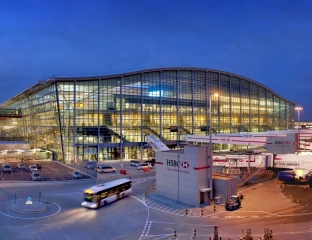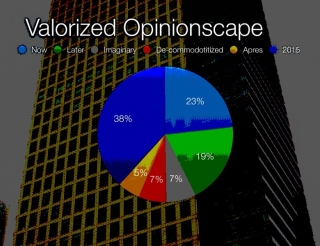Alan Gatt presents a transcript of a familiar, fictional, factual, farcical meeting which never happened, but might happen, or possibly already has – or may even be in progress at this very moment in time.
Good afternoon everyone.
All cleared print ID? Yes. If you could leave all your mobile gadgets – cameras, body-mounted vid-capture devices, smartcells, enhanced biros etcetera with Judy at the thumb-print-in desk please. And step through the magnetoarch… nobody got an old-fashioned metallic hip replacement – ha ha – no? Good. Thanks.
Everybody through OK? No anomalous readings, Judy? No? Good. If you could all find a seat – is there enough room? The room is quite small, em… sorry about that, but the EM suppression means that it has to be. Everyone got a seat now? Good.
Colleagues, on behalf of us all at the Trans-Conjectural Proposals Instigation Trust thank you for taking the time out of your energetic schedules to attend this brief stakeholder update presentation at this key watershed time for our iconic project. And yes, welcome along today to the splendid white-room facilities of the Querulant Suite at this new Idée Fixe Conference Centre.
We thank our hosts for the provision of these splendid facilities, not only for this windowless and unrecordable environment – just the thing! – but also for their reasonably-priced and exemplary underground car-park with its innovative numberplate and face-recognition technology demonstrator. All got your PINcards? Some of you have the subcutaneous upgrades, eh? Heh-heh. Good. Shouldn’t talk too much about car-parks, though.
To business…
You’ll all be familiar with the surprisingly rapid progress of our most recent Trans-Conjectural Proposal which has advanced in an inspirational and iconic fashion. Now is the time for us to transform this project into what we can now call a Global Trans-Conjectural Context-Framing Opportunity. To deliver this transformative, em, transformation, we have developed a delivery plan which will champion and shepherd this agenda. Stepping up to the plate on an interlinked basis, this plan is assured of delivering the appearance of three-hundred-and-sixty degree participation models within our context.
Our overarching management strategy will be driving forward our key activity delivery and measurement plan. The delivery plan will be in the form of an inspirational yet logical legal-entity action-plan vehicle which progresses up-front objectives emerging through this unique window of opportunity towards the delivery of our most ambitious and foremost logical key priorities. It safeguards the potential for a distinct opinionscaping context-framing outlook and will greenlight fund-channeling linkages into an entirely new dynamic.
A strategically central numbers game will provide a fundamental plank to access innovative fund sources underpinned by this transformational drive to manage ownership and own management of this delivery plan.
In due course, this special purpose vehicle will be enhanced and reinvigorated.
This development strategy is shared by key players and the uplift provided by the delivery plan mechanism is central to its delivery; it will unlock a more attractive, safer and better connected win-win managementscape and target-rich investmentscape for the key stakeholders here today.
And so contracts for community engagement initiatives will soon be in place, delivering on a range of public-relations improvements under the auspices of our best-practice masterplan which we outlined at the last presentation. These new community engagement contracts will provide us with the ideal public-realm participation management solution for the provision of the required consent-manufacturing services via this special purpose vehicle.
In due course, this special purpose vehicle will be enhanced and reinvigorated. This is expected to be fully available and framework-compliant within the context-framing consent-manufacturing mindscape which we have already achieved, all the while maximising shareholder value… Oh! Thank-you, no… em… yes, thank-you. Applause isn’t necessary – no, ha-ha! Thanks.
…Where was I? Ah yes… The continual securing of this self-referencing self-certified procedural approval feedback mechanism will unlock further yet imaginative, bigger, brighter and iconic leadership obscurantism.
This opportunity to shape the future with self-referencing enriched vitality is truly strategic, truly innovative and the radical transformation will not only provide fascinating narcissistic appeal within our own little circle of friends – ha ha – but also wider heritage compliance lipservice services outwith it. Inspirational inclusion misdirection initiatives when appropriate via incremental rearward-facing commitments once progressed will create the appearance of a real iconic international buzz.
our established undertaking of prioritising strategy themes and status updates will continue towards the feedback-enabled enhancement of project engagement resources
In conclusion, then, when we look back on what has been achieved so far in the shaping of the civic mindscape, the manipulation of the investment opportunityscape and the creation of a public opinionscape which is largely characterised by confusion if not ennui, we can look back on an approach – a resource – which we will continue to leverage towards the achievement of ever more enhanced shareholder value and stakeholder satisfaction.
So long as key deliverables are progressed in accordance with opportunities within the supply chain to anchor our central objectives with respect to this clear strategy, our established undertaking of prioritising strategy themes and status updates will continue towards the feedback-enabled enhancement of project engagement resources. This provides both measurable internal accountability and vital external obfuscation services.
The vision for this exciting journey is an innovative yet highly robust process which every stakeholder here will enjoy participating in. Every stakeholder here today is part of the process. The process is the future and the future is the process. We are the future. This is a very real possibility. It is within our grasp, we are nearly there. With your continued support and with the compliance and consent we have already engineered, rates of return much higher than those available in any other investmentscape will be assured. Thank you all.
…Ha-ha, thanks, yes, thank-you. Too kind… too kind. Thanks.
…Thank you for your time today. Questions will not be necessary. And now I think Judy’s got some special drinks and nibbles ready for us in the Dependency Suite… if you’d like to go through… please… thanks…


